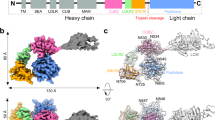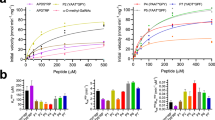Abstract
The crystal structure of an activation intermediate of human gastricsin has been determined at 2.4 Å resolution. The human digestive enzyme gastricsin (pepsin C) is an aspartic proteinase that is synthesized as the inactive precursor (zymogen) progastricsin (pepsinogen C or hPGC). In the zymogen, a positively-charged N-terminal prosegment of 43 residues (Ala 1p–Leu 43p; the suffix ‘p’ refers to the prosegment) sterically prevents the approach of a substrate to the active site. Zymogen conversion occurs in an autocatalytic and stepwise fashion at low pH through the formation of intermediates. The structure of the non-covalent complex of a partially-cleaved peptide of the prosegment (Ala 1p–Phe 26p) with mature gastricsin (Ser 1–Ala 329) suggests an activation pathway that may be common to all gastric aspartic proteinases.
This is a preview of subscription content, access via your institution
Access options
Subscribe to this journal
Receive 12 print issues and online access
$189.00 per year
only $15.75 per issue
Buy this article
- Purchase on Springer Link
- Instant access to full article PDF
Prices may be subject to local taxes which are calculated during checkout
Similar content being viewed by others
References
Fusek, M. & Vetvicka, V. Aspartic proteinases: physiology and pathology (CRC Press, New York, New York; 1995).
Herriott, R.M. Isolation crystallization and properties of swine pepsinogen. J. Gen. Physiol. 21, 501–540 (1938).
Herriott, R.M. Kinetics of the formation of pepsin from swine pepsinogen and identification of an intermediate compound. J. Gen. Physiol. 22, 65–78 (1939).
McPhie, P. A spectrophotometric investigation of the pepsinogen-pepsin conversion. J. Biol. Chem. 247, 4277–4281 (1972).
Moore, S.A., Sielecki, A.R., Chernaia, M.M., Tarasova, N.I. & James, M.N.G. Crystal and molecular structures of human progastricsin at 1.62 Å resolution. J. Mol. Biol. 247, 466–485 (1995).
James, M.N.G. & Sielecki, A.R. Molecular structure of an aspartic proteinase zymogen, porcine pepsinogen, at 1.8Å resolution. Nature 319, 33–38 (1986).
Auer, H.E. & Glick, D.M. Early events of pepsinogen activation. Biochemistry 23, 2735–2739 (1984).
Foltmann, B. & Jensen, A.L. Human progastricsin. Analysis of intermediates during activation into gastricsin and determination of the amino acid sequence of the propart. Eur J. Biochem. 128, 63–70 (1982).
Fujinaga, M., Chernaia, M.M., Tarasova, N.I., Mosimann, S.C. & James, M.N.G. Crystal structure of human pepsin and its complex with pepstatin. Protein Sci. 4, 960–972 (1995).
Davies, D.R. The structure and function of the aspartic proteinases. Annu. Rev. Biophys. Chem. 19, 189–215 (1990).
Schechter, I. & Berger, A. On the size of the active site in proteases. I. Papain Biochem. Biophys. Res. Common. 27, 157–162 (1967).
Yang, J., Teplyakov, A. & Quail, J.W. Crystal structure of the aspartic protease from Rhizomucor miehei at 2.15 Å resolution. J. Mol. Biol. 268, 449–459 (1997).
Cutfield, S.M. et al. The crystal structure of a major secreted aspartic proteinase from Candida albicans in complexes with two inhibitors. Structure 3, 1261–1267 (1995).
Glick, D.M., Shalitin, Y. & Hitt, C.R. Studies on the irreversible step of pepsinogen activation. Biochemistry 28, 2626–2630 (1989).
Foltmann, B., Harlow, K., Houen, G., Nielsen, P.K. & Sangild, P. Comparative investigations on pig gastric proteinases and their zymogens, in Aspartic Proteinases: Structure, Function, Biology and Biomedical Implications (ed. Takahashi, K.) 41–51 (Plenum Press, New York; 1995).
Nielsen, F.S. & Foltmann, B. Activation of porcine pepsinogen A: the stability of two non-covalent intermediates at pH 8.5. Eur. J. Biochem. 217, 137–142 (1993).
Richardson, J.S. & Richardson, D.C. Amino acid preferences for specific locations at the ends of α-helices. Science 240, 1648–1652 (1988).
Harper, E.T. & Rose, G.D. Helix stop signals in proteins and peptides: the capping box. Biochemistry 32, 7605–7609 (1993).
Dykes, C.W. & Kay, J. Conversion of pepsinogen into pepsin is not a one-step process. Biochem. J. 153, 141–144 (1976).
Glick, D.M., Shalitin, Y. & Hilt, C.R. Studies on the irreversible step of pepsinogen activation. Biochemistry 28, 2626–2630 (1989).
Kageyama, T. et al. Differences of activation processes and structure of activation peptides in human pepsinogens A and progastricsin. J. Biochem. 105, 15–22 (1989
Marciniszyn, Jr., J., Huang, J.S., Hartsuck, J.A. & Tang, J. Mechanism of intramolecular activation of pepsinogen. J. Biol. Chem. 251, 7095–7102 (1976).
Athauda, S.B.P., Tanji, M., Kageyama, T. & Takahashi, K. A comparative study on the N-terminal amino acid sequences and some other properties of six isozymic forms of human pepsinogens and pepsins. J. Biochem. 106, 920–927 (1989).
Rudenko, G., Bonten, E., d′Azzo, A. & Hol, W.G.J. Three-dimensional structure of the ‘human protective protein’: structure of the precursor form suggests a complex activation mechanism. Structure 15, 1249–1259 (1995).
Coulombe, R. et al. Structure of human procathepsin L reveals the molecular basis of inhibition by the prosegment. EMBO J. 15, 5492–5503 (1996).
Cygler, M. et al. Structure of rat procathepsin B. Model for inhibition of cysteine protease activity by the proregion. Structure 4, 405–416 (1996).
Turk, D., Podobnik, M., Kuhelj, R., Dolnar, M. & Turk, V. Crystal structures of procathepsin B at 3.2 and 3.3 Å resolution reveal an interaction motif between a papain-like cysteine protease and its propeptide. FEBS Lett. 384, 211–214 (1996).
Bonten, E.J. et al. Lysosomal protective protein/cathepsin A. Role of the “linker” domain in catalytic activation. J. Biol. Chem. 270, 26441–26445 (1995).
Sorenson, S.O. Van den Hazel, H.B., Kielland-Brandt, M.C & Winther, J.R. pH-dependent processing of yeast carboxypeptidase Y by proteinase A in vivo and in vitro. Eur. J. Biochem. 220, 19–27 (1994).
Otwinowski, Z. in Data Collection and Processing (eds Sawyer, L., Isaacs, N. & Bailey, S.) 556–562 (SERC Daresbury Laboratory, Warrington, UK; 1993).
Navaza, J. AMoRe: an automated package for molecular replacement. Acta Crystallogr. A50, 157–163 (1994).
Pannu, N.S. & Read, R.J. Improved structure refinement through maximum likelihood. Acta Crystallogr. A52, 659–668 (1996).
Brunger, A.T. XPLOR: a system for X-ray crystallography and NMR (Yale University Press, New Haven, Connecticut; 1993).
CCP4, in The CCP4 suite: programs for protein crystallography. Acta Crystallogr. D50, 760–763 (1994).
Jones, T.A. & Kjeldgaard, M. O the Manual, Version 5.11 (Uppsala, Sweden; 1995).
Esnouf, R.M. An extensively modified version of MolScript that includes greatly enhanced colouring capabilities. J. Mol. Graphics 15, 133–138 (1997).
Merritt, E.A. & Murphy, M.E.P. Raster3D version 2.0: a program for photorealistic molecular graphics. Acta Crystallogr. D50, 869–873 (1994).
Hayano, T., Sogawa, K., Ichihara, Y, Fuji-Kuriyama, Y. & Takahashi, K. Primary structure of human pepsinogen C gene. J. Biol. Chem. 263, 1382–1385 (1988).
Taggart, R.T. et al. Human pepsinogen C (progastricsin). Isolation of cDNA clones, localization to chromosome 6, and sequence homology with pepsinogen A. J. Biol. Chem. 264, 375–379 (1989).
Kageyama, T. & Takahashi, K. The complete amino acid sequence of monkey progastricsin J. Biol. Chem. 261, 4406–4419 (1986).
Ichihara, Y, Sogawa, K., Morohashi, K., Fuji-Kuriyama, Y. & Takahashi, K. Nucleotide sequence of a nearly full-length cDNA coding for pepsinogen of rat gastric mucosa. Eur. J. Biochem. 161, 7–12 (1986).
Kageyama, T. et al. Gastric procathepsin E and progastricsin from guinea pig. J. Biol. Chem. 267, 16450–16459 (1992).
Sogawa, K., Fuji-Kuriyama, Y., Mizukami, Y., Ichihara, Y. & Takahashi, K. Primary structure of human pepsinogen gene. J. Biol. Chem. 258, 5306–5311 (1983).
Kageyama, T. & Takahashi, K. The complete amino acid sequence of monkey pepsinogen A. J. Biol. Chem. 261, 4395–4405 (1986).
Baudys, M. & Kostka, V. Covalent structure of chicken pepsinogen. Eur. J. Bioch. 136, 89–99 (1983).
Tsukagoshi, N. et al. Nucleotide sequence and expression in Esherichia coli of cDNA of swine pepsinogen: involvement of the amino-terminal portion of the activation peptide segment in restoration of the functional protein. Gene 65: 285–292 (1988).
Author information
Authors and Affiliations
Rights and permissions
About this article
Cite this article
Khan, A., Cherney, M., Tarasova, N. et al. Structural characterization of activation ‘intermediate 2’ on the pathway to human gastricsin. Nat Struct Mol Biol 4, 1010–1015 (1997). https://doi.org/10.1038/nsb1297-1010
Received:
Accepted:
Published:
Issue Date:
DOI: https://doi.org/10.1038/nsb1297-1010
This article is cited by
-
Conformational switching in an aspartic proteinase
Nature Structural Biology (1998)
-
Splitting image
Nature Structural Biology (1997)



